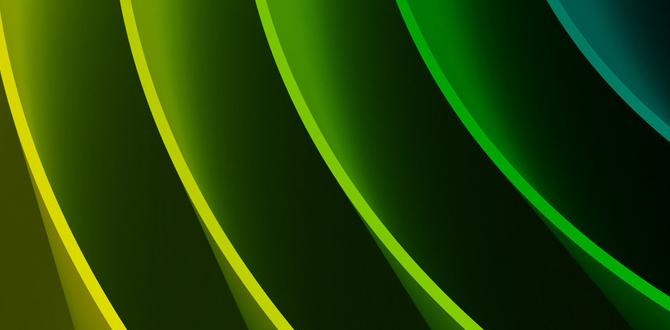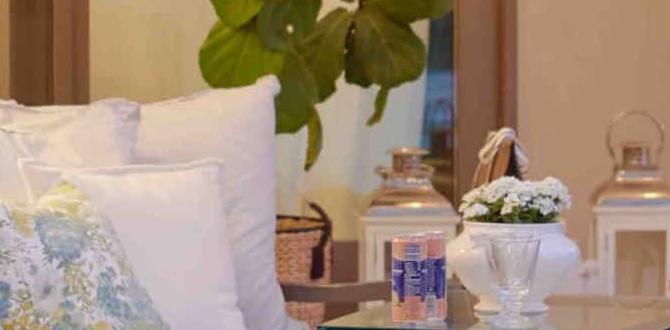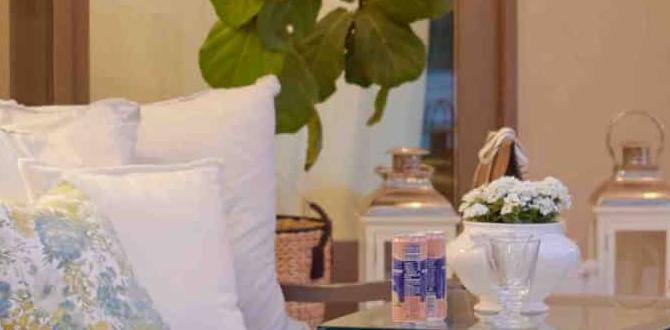Have you ever walked outside at night and felt a little scared or uneasy? The right outdoor lighting can change that completely. But what colors are better for outdoor lighting and why? This is a question many people ask. Choosing the right colors can make your yard feel warm and welcoming, or cold and uninviting.
Imagine a bright, sunny day. The colors around you are vibrant and lively. Now think about how those colors can transform at night. With the right lights, your garden can look magical. Did you know that warm colors, like yellow and orange, can make us feel happy and relaxed? They brighten up dark spaces and create a cozy vibe. On the other hand, cool colors, like blue and green, can be calming but might feel distant or chilly.
In this article, we will explore which colors work best for outdoor lighting. You will discover tips that not only enhance your home’s beauty but also improve safety. Are you ready to light up your nights? Let’s dive in and find out more!
What Colors Are Better For Outdoor Lighting And Why? Outdoor Lighting Plays A Significant Role In Enhancing The Aesthetics, Safety, And Functionality Of External Spaces. When Considering What Colors Are Better For Outdoor Lighting, It’S Essential To Understand Not Only The Visual Appeal But Also The Impact On Mood, Ambiance, And Practicality. The Following Discussion Will Explore Different Colors Of Outdoor Lighting, Their Benefits, And Why Some Are More Effective Than Others. Warm White Lights Warm White Lighting, Typically Around 2700K To 3000K On The Kelvin Scale, Is One Of The Most Popular Choices For Outdoor Environments. This Color Temperature Creates A Cozy And Inviting Atmosphere, Making It Ideal For Patios, Gardens, And Outdoor Dining Areas. Here’S Why Warm White Is Often Recommended: – **Enhances Ambiance**: Creates A Relaxed Setting, Suitable For Gatherings And Leisure. – **Makes Spaces Appealing**: Warmer Tones Complement Natural Surroundings, Highlighting Plants And Architectural Features Beautifully. – **Safety**: Provides Adequate Visibility Without Being Harsh On The Eyes. Cool White Lights Cool White Lighting, Which Usually Ranges From 4000K To 5000K, Offers A Brighter And More Energetic Atmosphere. This Color Is Often Used In Outdoor Commercial Settings, But It Also Serves Residential Purposes. Here Are The Advantages Of Cool White Lights: – **High Visibility**: Ideal For Security Purposes, As It Illuminates Spaces More Effectively. – **Modern Look**: Gives Outdoor Areas A Contemporary Feel, Enhancing Different Architectural Styles. – **Increases Alertness**: The Brighter Tone Can Help Keep People Awake And Alert, Making It A Good Choice For Late-Night Activities. Color-Changing Led Lights Color-Changing Led Lights Offer Versatility And Creativity In Outdoor Lighting. These Lights Can Shift Between Various Hues, Allowing Homeowners To Customize Their Outdoor Experience. Here’S Why These Lights Are Gaining Popularity: – **Mood Setting**: Allows Adaptation Of Color According To Events, Seasons, Or Personal Preference. – **Festivity**: Perfect For Parties And Holidays, Adding A Festive Vibe To Gatherings. – **Enhanced Visual Interest**: Provides An Artistic Touch To Landscaping, Making Gardens And Pathways More Dynamic. Soft Pastels Pastel Colors Such As Soft Pinks, Light Blues, And Pale Yellows Are Becoming An Unconventional Choice For Outdoor Lighting. While Not The Most Standard Option, They Can Create A Unique Atmosphere. Here’S Why You Might Consider Pastels: – **Subtle Elegance**: Adds A Dreamy Quality To Spaces, Making Them Feel Whimsical And Serene. – **Complementing Nature**: Soft Colors Often Harmonize Well With Floral Displays And Green Landscaping. – **Versatile Use**: Great For Decorative Lighting Along Walkways Or In Gardens Where A More Gentle Glow Is Desired. Conclusion When Determining What Colors Are Better For Outdoor Lighting, It Ultimately Depends On The Intended Use, Desired Ambiance, And Personal Preference. Warm White Remains The Go-To For Its Welcoming Qualities, While Cool Whites Enhance Visibility And Security. Color-Changing Leds And Soft Pastels Offer Unique Alternatives For Those Looking To Express Creativity Through Outdoor Lighting. By Understanding The Benefits Of Each Color, Homeowners Can Make Informed Decisions That Enhance Both The Utility And Beauty Of Their Outdoor Spaces.

What Colors Are Better for Outdoor Lighting and Why
Choosing the right color for outdoor lighting can change your space dramatically. Warm white lights create a cozy atmosphere, perfect for relaxing evenings. Cool white lights brighten up areas, making them safer and more inviting. Did you know that amber lights can attract fewer bugs? They’re great for summer nights! By picking the right colors, you can enhance safety and set the perfect mood in your yard. Which color will you choose for your outdoor oasis?Understanding the Color Temperature Scale
Explanation of Kelvin (K) scale. Importance of color temperature in outdoor lighting.The color temperature scale uses Kelvin (K) to measure light’s warmth or coolness. Lower values, like 2700K, give a cozy yellow light, while higher values, like 5000K, shine bright and blue. Choosing the right color temperature for outdoor lighting is key; it affects safety and mood. For example, warm lighting feels inviting and helps us relax, while cool lighting improves visibility for evening adventures. So, think of the Kelvin scale as your lighting mood-ring!
| Kelvin Temperature (K) | Color Appearance |
|---|---|
| 2700K | Warm Yellow |
| 3000K | Soft White |
| 4000K | Cool White |
| 5000K | Bright Daylight |
Warm Colors: The Cozy Ambiance
Characteristics of warm colors (e.g., yellow, orange). Benefits of warm colors for outdoor spaces.Warm colors, like yellow and orange, create a delightful vibe that makes outdoor spaces feel inviting. These hues mimic the sun’s glow, which can brighten even the cloudiest days. Using warm colors in your lights can turn your backyard into a cozy retreat, great for evening chats or a barbecue. They help you relax and feel at home, even under the stars. Why not set the mood and spark some joy? After all, who wouldn’t prefer to sip lemonade in sunshine-like glow?
| Warm Color | Characteristics | Benefits |
|---|---|---|
| Yellow | Cheerful and vibrant | Boosts happiness |
| Orange | Warm and inviting | Encourages social interaction |
Cool Colors: The Crisp and Modern Look
Characteristics of cool colors (e.g., blue, white). Benefits of cool colors for outdoor lighting.Cool colors like blue and white create a fresh and modern vibe in outdoor lighting. These shades are crisp and clean, making spaces feel larger and more inviting. They can also enhance *safety* by improving visibility at night. Plus, who doesn’t love a little winter wonderland effect in the garden, even in summer? Use them wisely, and your yard will shine like a superstar!
| Color | Characteristics | Benefits |
|---|---|---|
| Blue | Calm, relaxing | Increases visibility, creates a serene space |
| White | Clean, bright | Enhances safety, adds a modern touch |
Color Psychology in Outdoor Lighting
How colors influence mood and atmosphere. Examples of settings where specific colors are effective.Colors can change how we feel and how a place looks. For example, warm colors like red and orange can make us feel excited and happy. Cool colors like blue and green help us feel calm and peaceful. Using the right colors for outdoor lighting can really set the mood!
| Color | Effect | Best Settings |
|---|---|---|
| Red | Exciting | Parties |
| Blue | Calm | Outdoor retreats |
| Green | Refreshing | Gardens |
| Yellow | Cheerful | Family dinners |
So, next time you pick colors for your lights, remember: it’s more than just looks—it’s about feelings! Brighten up your space and your mood!
Functionality of Different Colors in Outdoor Spaces
Areas where warm colors are most suitable. Areas where cool colors enhance visibility and safety.Warm colors, like yellows and oranges, make outdoor spaces feel cozy and inviting. They’re perfect for areas like patios where you want to relax or sip lemonade. On the flip side, cool colors, such as blue and white, help you see better at night. They are great for driveways and pathways where safety is key. Who wants to trip over a garden gnome in the dark, right?
| Color Type | Best Areas |
|---|---|
| Warm Colors | Patios, Decks & Gardens |
| Cool Colors | Driveways, Pathways & Entrances |
Combining Colors for a Harmonious Outdoor Environment
Tips on mixing warm and cool colors. Creating layered lighting using color combinations.Mixing warm and cool colors can create a lovely outdoor space. Warm colors like orange and yellow bring energy. Cool colors like blue and green add calmness. Use both to balance your area.
Layered lighting helps set the mood. Try these tips:
- Use warm lights near seating areas.
- Add cool lights along pathways.
- Combine colors in different heights for depth.
By mixing colors wisely, your outdoor lighting will feel inviting. The right colors make a difference!
What colors should you use for outdoor lighting?
Warm colors attract attention, while cool colors create calmness. Using a mix can enhance your space beautifully.
Energy Efficiency and Color Choices
Impact of LED colors on energy consumption. Ecofriendly color choices for outdoor lighting.Choosing the right colors for outdoor lighting can save energy and brighten up your space—literally! LED lights come in various colors, and using cooler shades can reduce energy use. Studies show that LED lights consume up to 75% less energy than traditional bulbs. How cool is that? Plus, picking eco-friendly colors helps the planet! Here’s a quick look at color choices and their energy impact:
| Color | Energy Efficiency | Eco Impact |
|---|---|---|
| Warm White | Moderate | Good |
| Cool White | High | Better |
| Colored Lights | Varies | Depends |
So, think wisely before you decorate! Your electrical bill—and the Earth—will thank you!
Seasonal Color Adaptations in Outdoor Lighting
How outdoor lighting colors can change with the seasons. Recommendations for seasonal color themes.Outdoor lighting can change colors beautifully with the seasons. In summer, bright whites and cool blues create a fresh vibe. In autumn, warm oranges and yellows offer cozy feelings. Winter invites soft whites and icy blues for a magical look. Spring blooms with vibrant pastels, like pinks and greens. These colors work great to match nature’s moods at different times of the year.
- **Summer:** Bright whites and cool blues
- **Fall:** Warm oranges and yellows
- **Winter:** Soft whites and icy blues
- **Spring:** Pastels like pinks and greens
What lights are best for each season?
Bright LED lights work well in summer. Soft glow lamps suit autumn. Use cool white lights for winter, and choose warm shades in spring.
Conclusion
In summary, warm colors like amber and soft white are best for outdoor lighting. They create a cozy feel and enhance safety. Cool colors, like blue, can be used for effect but may not be as inviting. You can try these colors in your yard to see what you like best. For more tips, keep exploring outdoor lighting ideas!FAQs
What Color Temperatures Are Considered Ideal For Outdoor Lighting, And How Do They Affect Visibility And Ambiance?For outdoor lighting, a color temperature between 3000K and 5000K is best. This means the light can look warm like sunset or cool like clear blue skies. Warm lights (around 3000K) make you feel cozy, while cool lights (around 5000K) help you see better in the dark. Both types help create a nice atmosphere outside.
How Do Different Colors Of Outdoor Lighting Impact Safety And Security In Residential Areas?Different colors of outdoor lighting can change how safe a place feels. For example, white light makes it brighter and helps us see better. Yellow or soft lights can make it feel cozy but might not light up dark areas as much. Red lights can look pretty but don’t offer good visibility. Using brighter lights in the front and darker colors in the back can help keep you safe.
What Role Do Warm Versus Cool Light Colors Play In Enhancing Landscape Features And Outdoor Spaces?Warm light colors, like yellow and orange, make places feel cozy and inviting. They can highlight flowers and trees, making them look beautiful. Cool light colors, like blue and white, create a calm and peaceful feeling. They can make water features and stone paths stand out. Together, warm and cool lights help us enjoy outdoor spaces more!
Are There Specific Colors Of Outdoor Lighting That Can Attract Or Deter Wildlife, And How Does This Influence Garden Design?Yes, some colors of outdoor lights can attract or scare away animals. For example, yellow and orange lights are less bright and help keep bugs away. On the other hand, bright white lights can attract moths and other insects. When we design our gardens, we can choose light colors that help us keep animals away or bring in friendly ones we like to see.
How Does The Color Of Outdoor Lighting Interact With Various Architectural Styles And Exterior Materials?The color of outdoor lighting can change how a building looks. For example, warm yellow light can make a brick house feel cozy. Bright white light can make modern, shiny surfaces look cool and sleek. Different colors highlight different materials, like wood or metal. So, the right light makes buildings more beautiful and inviting!





